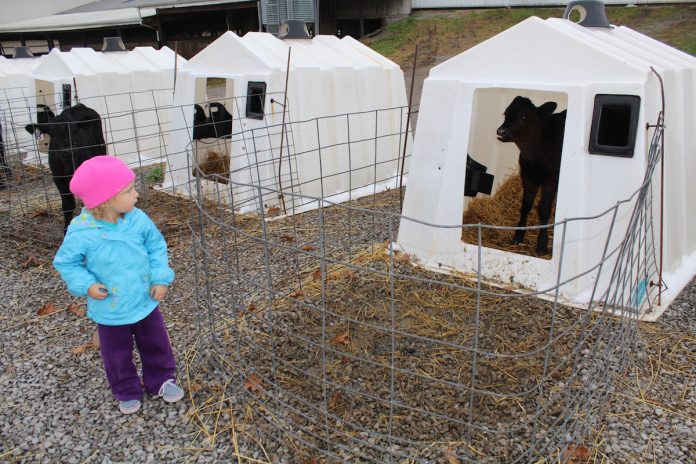This year, we have experienced nine days with a high temperature above 77 F, which is the upper critical temperature for calves less than one-month-old. Above this temperature, calves experience a decreased rate of gain. Severe heat stress can decrease the rate of gain by about 0.14 pounds per day.
The good thing in the spring is that nighttime low temperatures still allow calves to dissipate heat efficiently. The greatest heat stress occurs when nighttime lows stay above the upper critical temperature of 77 F for calves under one month and 73 F for calves over one month.
Hutch basics
Last year during Farm Science Review, we had a demonstration in the OSU livestock area showing the internal temperature difference between a calf hutch that was closed and one that had all its vents open. The open hutch had a slower internal temperature rise and a lower internal humidity.
Research from Penn State shows that summer hutch placement with the opening facing east and 10 feet between hutch rows maximizes airflow into the hutches.
The next step to decreasing heat stress is to elevate the calf hutch. Elevating the hutch 1.5 inches above the bedding significantly decreases airborne bacteria counts within the hutch. Using a concrete block to elevate the back of the calf hutch about 8 inches lowered internal temperature and carbon dioxide levels along with calf respiration rates compared to the non-elevated hutches.
For calves housed in naturally ventilated barns, fan cooling is beneficial during times of heat stress. Running fans during the day improved average daily gain by 23%, feed efficiency by 20% and lowered daily respiration rates compared to the calves who only had natural ventilation. Both groups of calves received the same amount of milk and ate similar amounts of calf starter.
Shade
Providing shade through the use of shade cloth can help reduce heat stress in calf hutches. An 80% shade cloth reduces the internal temperature of plastic calf hutches by about 4 F and lowers peak rectal temperatures by 0.5 F when outside temperatures are in the 90s. Shade cloth also lowered calf skin temperature and respiratory rates by 10 breaths per minute during the hottest part of the day.
Providing outside runs for hutch-housed calves can also help them find a more comfortable spot on hot days. Shade curtains can also be useful to help keep barn raised calves cool if the sun shines directly in on them and they cannot find a shaded spot.
Water
At all times of the year, calves should be provided with fresh water. This is even more critical in the summer. Under non-heat stress conditions, the amount of water a calf consumes is correlated to the amount of milk consumed and starter intake. However, when temperatures exceed 77 F, calf water consumption increases independently of the amount of grain a calf is consuming.
Calf water buckets should look inviting so that a calf can explore them and find the water. Buckets should also be dumped and rinsed daily. Daily rinsing increasing the rate of gain by 0.07 pounds per day over weekly rinsing. Weekly rinsing was better than every other week with every other week rinsing experiencing even lower rates of gain and increased illness.
Feeding
During heat stress, calves need increased calories; however, unlike during cold stress, calves don’t usually increase starter intake. To help encourage starter intake, small handfuls of fresh starter should be provided to young calves.
During hot humid temperatures, extra attention needs to be paid to the calf starter to be sure it is fresh and not moldy. Dividers between the calves’ water bucket and grain can help limit water transfer to the grain bucket.
To increase calories, more milk should be fed during times of heat stress. A healthy calf will rarely refuse to drink additional milk.
There is limited research on how much extra energy is needed for calves to combat heat stress, but in beef cattle, a 7% increase in energy is recommended when animals exhibit shallow panting and an 11-to-25% increase when open-mouth panting is present.
Calves born to heat stress dams also have lower average daily gain than calves from dams that were cooled during the dry period. Heat stress can reduce colostrum IgG content. Even when IgG content was the same between heat stressed dams and cooled dams the calves from the heat stressed dams had a lower passive immunity transfer.
Adjustments to your calf care program to prevent heat stress is critical in these immunocompromised calves.













